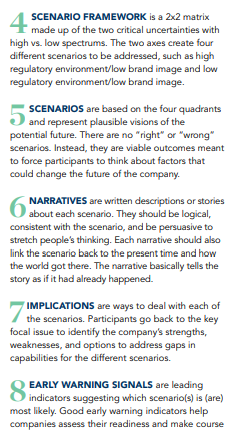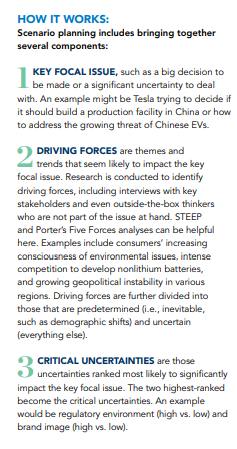Based on the picture below, explain each briefly like you are teaching this to your students or give a summary explanation about how scenario planning works. Key focal issue Driving forces Critical uncertainties
Based on the picture below, explain each briefly like you are teaching this to your students or give a summary explanation about how scenario planning works. Key focal issue Driving forces Critical uncertainties
Management, Loose-Leaf Version
13th Edition
ISBN:9781305969308
Author:Richard L. Daft
Publisher:Richard L. Daft
Chapter11: Managing Change And Innovation
Section: Chapter Questions
Problem 3CFCA
Related questions
Question
Based on the picture below, explain each briefly like you are teaching this to your students or give a summary explanation about how scenario planning works.
- Key focal issue
- Driving forces
- Critical uncertainties
- Scenario Framework

Transcribed Image Text:A SCENARIO FRAMEWORK is a 2x2 matrix
made up of the two critical uncertainties with
high vs. low spectrums. The two axes create four
different scenarios to be addressed, such as high
regulatory environment/low brand image and low
regulatory environment/low brand image.
53
SCENARIOS are based on the four quadrants
and represent plausible visions of the
potential future. There are no "right" or "wrong"
scenarios. Instead, they are viable outcomes meant
to force participants to think about factors that
could change the future of the company.
6 NARRATIVES are written descriptions or stories
about each scenario. They should be logical,
consistent with the scenario, and be persuasive to
stretch people's thinking. Each narrative should also
link the scenario back to the present time and how
the world got there. The narrative basically tells the
story as if it had already happened.
IMPLICATIONS are ways to deal with each of
the scenarios. Participants go back to the key
focal issue to identify the company's strengths,
weaknesses, and options to address gaps in
capabilities for the different scenarios.
EARLY WARNING SIGNALS are leading
O indicators suggesting which scenario(s) is (are)
most likely. Good early warning indicators help
companies assess their readiness and make course

Transcribed Image Text:HOW IT WORKS:
Scenario planning includes bringing together
several components:
KEY FOCAL ISSUE, such as a big decision to
be made or a significant uncertainty to deal
with. An example might be Tesla trying to decide if
it should build a production facility in China or how
to address the growing threat of Chinese EVs.
O DRIVING FORCES are themes and
trends that seem likely to impact the key
focal issue. Research is conducted to identify
driving forces, including interviews with key
stakeholders and even outside-the-box thinkers
who are not part of the issue at hand. STEEP
and Porter's Five Forces analyses can be helpful
here. Examples include consumers' increasing
consciousness of environmental issues, intense
competition to develop nonlithium batteries,
and growing geopolitical instability in various
regions. Driving forces are further divided into
those that are predetermined (i.e., inevitable,
such as demographic shifts) and uncertain
(everything else).
3
CRITICAL UNCERTAINTIES are those
uncertainties ranked most likely to significantly
impact the key focal issue. The two highest-ranked
become the critical uncertainties. An example
would be regulatory environment (high vs. low) and
brand image (high vs. low).
Expert Solution
This question has been solved!
Explore an expertly crafted, step-by-step solution for a thorough understanding of key concepts.
Step by step
Solved in 2 steps with 3 images

Recommended textbooks for you

Management, Loose-Leaf Version
Management
ISBN:
9781305969308
Author:
Richard L. Daft
Publisher:
South-Western College Pub

Management, Loose-Leaf Version
Management
ISBN:
9781305969308
Author:
Richard L. Daft
Publisher:
South-Western College Pub